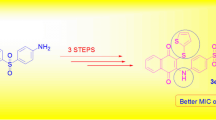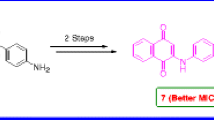Abstract
Antibiotic resistance is a major health problem; so there is a emerging need for developing new antibiotic agents. A novel series of (6-methoxy-2-naphthyl) propanamide derivatives were synthesized and evaluated for their potential antibacterial activity. The minimum inhibitory concentration of these compounds were determined by microdilution technique against five known strains of bacteria. Test strains included three Gram-positive strains (Streptococcus pneumonia, Bacillus subtilis and Staphylococcus aureus) and two Gram-negative strains (Escherichia coli and Salmonella typhimurium). According to the observed antibacterial activity results showed that compounds N-(4-(2-(5-bromo-2-hydroxybenzylidene)hydrazine carbonyl) phenyl)-2-(6-meth oxynaphthalen-2-yl)propanamide 2d and N-(4-(2-(2,4-dichlorobenzylidene)hydrazine carbonyl)phenyl)-2-(6-methoxy-naphthalen-2-yl)propanamide 2j has potent antibacterial activity against B. subtilis (minimal inhibitory concentrations 1.95 µg/ml). Also 2-(6-methoxynaphthalen-2-yl)-N-(4-(2-(4-oxopentan-2-ylidene)hydrazinecarbonnyl)phenyl) propanamide 6 showed potent antibacterial activity against S. pneumonia (minimal inhibitory concentrations 1.95 µg/ml) compared to Naproxen (7.81, 15.63 µg/ml) and the reference drug Ampicillin (7.81 µg/ml). Two of the synthesized compounds, namely, 2j and 2k exhibited more potent antibacterial activity than the reference drugs (Gentamicin and Ampicillin) against all the test strains of bacteria. Molecular docking simulation was also carried out for Enoyl-aceyl carrier protein reductase enzyme, which is responsible for catalyzing the final step of bacterial fatty acid biosynthesis and is an attractive target for the development of novel antibacterial agents. In addition, generation of 3D pharmacophore model and quantitative structure–activity relationship models were combined to explore the structural requirements controlling the observed antibacterial properties.









Similar content being viewed by others
References
Abadi AH, Laufer S, Lehmann (2001) Synthesis and cyclo-oxegenase inhibitory properties of novel 2-(6-methoxy-2-naphthyl)propanoic acid derivatives. J Arch Pharm Pham Med Chem 334:104–106
Ahmed Z, Abdel-Azeem AZ, Abdel-Hafez AA, El-Karamany GS, Farag HH (2009) Chlorzoxazone esters of some non-steroidal anti-inflammatory (NSAI) carboxylic acids as mutual prodrugs: design, synthesis, pharmacological investigations and docking studies. Bioorg Med Chem 17:3665–3670
Alkuraishy HM (2012) Antibacterial action of discriminating cyclo-oxygenase-2 inhibitors: in vitro study: consideration and appraisal. J Clin Res Health Care Manage 3(2):1–10
Al-Sehemi AGM, El-Sharief AMSh, Ammar YA (2006) Propionic acids in organic synthesis: novel synthesis of benzimidazole 3,1benzoxazine, 3-aminoquinazoline and 3-aminothieno[2,3-d]pyrimidine derivatives containing 2-naphthyl propionyl moiety. Indian J Chem 45B:450–455
Amir M, Kumar H, Javed SA (2008) Condensed bridgehead nitrogen heterocyclic system: synthesis and pharmacological activities of 1, 2, 4-triazolo-[3, 4-b]-1, 3,4-thiadiazole derivatives of ibuprofen and biphenyl-4-yloxy acetic acid. Eur J Med Chem 43:2056–2066
Annadurai S, Guha-Thakurta A, Sa B, Ray SDR, Chakrabarty A (2002) Experimental studies on synergism between aminoglycosides and the antimicrobial anti-inflammatory agent diclofenac sodium. J Chemother 14:47–53
Annadurai S, Basu S, Ray S, Dastidar SG, Chakrabarty AN (1998) Anti-bacterial activity of the anti-inflammatory agent diclofenac sodium. J Exp Biol 36:86–90
Bender AB, Kristiansen JE (1999) Antimicrobial effects of anesthetics and analgesics. UgeskrLaeger 161(42):5814–5817
Bharti SK, Nath G, Tilak R, Singh SK (2010) Synthesis, anti-bacterial and anti-fungal activities of some novel Schiff bases containing 2,4-disubstituted thiazole ring. Eur J Med Chem 45:651–660
Campbell JW, Cronan JE (2001) Bacterial fatty acid biosynthesis: targets for antibacterial drug discovery. J Annu Rev Microbiol 55:305–332
Choon SB, Lee HS, Kim SS, Song HJ, Sung YJ, Kim JI, Chung IS, Sun HS, Park DH, Lee YS (2002) Effects of selective cyclooxygenase-2 inhibitor and non-selective NSAIDs on helicobacter pylori-induced gastritis in mongolian gerbils. Helicobacter 7(1):14–21
Dastidar SG, Jairaj J, Mookerjee M, Chakrabarty AN (1997) Studieson anti-microbial effect of the anti-histaminic phenothiazine trimeprazine tartrate. Acta Microbiol Immun Hung 44:241–247
Doležal M, Palek L, Vinšová J, Buchta V, Jampílek J, Kráľová K (2006) Substituted pyrazinecarboxamides: synthesis and their biological evaluation. Molecules 11:242–256
Doležal M, Čmedlová P, Palek L, Vinšová J, Kuneš J, Buchta V, Jampílek J, Kráľová K (2008) Synthesis and biological evaluation of pyrazinecarboxamides. Eur J Med Chem 43:1105–1113
Dutta NK, Annadurai S, Mazumdar K, Dastidar SG, Kristiansen JE, Molnar J et al. (2007) Potential management of resistant microbial infections with a novel non-antibiotic: the anti-inflammatory drug diclofenac sodium. Int J Antimicrob Agents 30:242–249
Dutta NK, Mazumdar K, Baek MW, Kim DJ, Na YR, Park SH, Lee HK, Lee BH, Park JH (2008a) In vitro efficacy of diclofenac against Listeria monocytogenes. Eur J Clin Microbiol Infect Dis 27(4):315–319
Dutta NK, Mazumdar K, Seok SH, Park JH (2008b) The anti-inflammatory drug diclofenac retains anti-listerial activity in vivo. Lett Appl Microbiol 47:106–111
Eissa SI, Farrag AM, Galeel AAA (2013) Non-carboxylic analogues of aryl propionic acid: synthesis, anti-inflammatory, analgesic, antipyretic and ulcerogenic potential. Drug Res 63:1–8
Fatehia KM (2010) Synthesis, reactions and antimicrobial activity on some novel phthalazinones derivatives. Der Chem Sin 11:20–31
George RF, Ismail NSM, Stawinski J, Girgis AS (2013) Design, synthesis and QSAR studies of dispiroindole derivatives as new antiproliferative agents. Eur J Med Chem 68:339–351
Girgis AS, Stawinski J, Ismail NSM, Farag H (2012) Synthesis and QSAR study of novel cytotoxic spiro[3H-indole-3,2′(1′H)-pyrrolo[3,4-c]pyrrole]-2,3′,5′(1H, 2′aH, 4′H)-triones. Eur J Med Chem 47:312–322
Heath RJ, White SW, Rock CO (2001) Lipid biosynthesis as a target for antibacterial agents. Prog Lipid Res 40:467–497
Heerding DA, Chan G, DeWolf WE, Fosberry AP, Janson CA (2001) 1,4 Disubstituted imidazoles are potential antibacterial agents functioning as inhibitors of enoyl acyl carrier protein reductase (FabI). Bioorg Med Chem Lett 11:2061–2065
Helal MH, Abbas SY, Salem MA, Farrag AA, Ammar YA (2013) Synthesis and characterization of new types of 2-(6-methoxy-2- naphthyl)propionamide derivatives as potential antibacterial and antifungal agents. Med Chem Res 22:225598–225609
Ismail M, Lehmann J, Abou El Ella DA, Albohy A, Abouzid KAM (2009) Lonazolac analogues: molecular modeling, synthesis, and in vivo anti-inflammatory activity. Med Chem Res 18(9):725–744
Kalgutkar AS, Crews BC, Scott W, Marnett AB, Kozak KR, Remmel RP, Marnett L (2000) Biochemically based design of cyclo-oxygenase-2 (COX-2) inhibitors: facile conversion of nonsteroidal anti-inflammatory drugs to potent and highly selective COX-2 inhibitors. J Pharm 97(2):925–930
Khalifa M, Ismail MMF, Eissa S (2012) Design and synthesis of novel 6-methoxynaphthalene derivatives with potential anticancer activity. Der Pharm Chem 4:1552–1566
Kristiansen JE (1979) Experiments to illustrate the effect of chlorpromazine on the permeability of the bacterial cell wall. Acta Path Microbiol Scand 87(B):317–319
Kristiansen JE, Mortensen I (1987) Anti-bacterial effect of four phenothiazines. Pharmacol Toxicol 60:100–103
Kurumbail RG, Stevens AM, Gierse JK, McDonald JJ, Stegeman RA, Pak JY, Gildehaus D, Miyashiro JM, Penning TD, Seibert K, Isakson PC, Stallings WC (1996) Nature 384:644–648
Levit GL, Anikina LV, Vikharev YuB, Demin AM, Safin VA, Matveeva TV, Krasnov VP (2002) Synthesis and anti-inflammatory and analgesic activity of Naproxen amides with amino acid derivatives. Pharm Chem J 36(5):12–15
Loncle C, Brunel JM, Vidal N, Dherbomez M, Letourneux Y (2004) Synthesis and antifungal activity of cholesterol-hydrazone derivatives. Eur J Med Chem 39:1067–1071
Manna KK, Dastidar SG (2001) The anti-hypertensive drug propranolol hydrochloride (carditap): its anti-bacterial property. In: Chakrabarty AN, Dastidar SG (eds) Proceedings of national congress of IAMM, Stanford University Highwire Press, 984:pp 137–141
Mark AS, William HM, Kenneth AN, Walter JB, DeWolf Walter E (2003) Indole naphthyridinones as inhibitors of bacterial enoyl-ACP reductases FabI and FabK. J Med Chem 46:1627–1635
Marnett LJ, Kalgutkar AS (1998) Design of selective inhibitors of cyclooxygenase-2 as nonulcerogenic anti-inflammatory agents. Curr Opin Chem Biol 2:482–490
Metwally KA, Lashine M, EL-Sadek ME, EL-Fayomi HM, Yaseen SH (2006) Non-carboxylic analogues of arylpropionic acids: synthesis, anti-inflammatory activity and ulcerogenic potential. Bull Fac Pharm Cairo Univ 44(1):185–195
Miller WH, Newlander KA, Seefeld MA, Uzinskas IN, Dewolf WE, Jr., Jakas DR (2001) Fab i inhibitors. C.A. patent No.WO2001027103A1. 19
Miller WH, Seefeld MA, Newlander KA, Uzinskas IN, Burgess WJ (2002) Discovery of aminopyridine-based inhibitors of bacterial enoyl-ACP reductase (FabI). J Med Chem 45:3246–3356
Molna´r J, Ma´ndi Y, Kira´ly (1976) Anti-bacterial effect of somephenothiazine compounds and the R-factor elimination by chlorpromazine. J Acta Microbiol Acad Sci Hung 23:45–54
Obad J, Šušković J, Kos B (2015) Antimicrobial activity of ibuprofen: new perspectives on an “Old” non-antibiotic drug. Eur J Pharma Sci 71:93–98
Payne DJ, Miller WH, Berry V, Brosky J, Burgess W (2002) Discovery of a novel and potent class of FabI-directed antibacterial agents. J Antimicrob Agents Chemother 46:3118–3124
Pouplana R, Lozano JJ, Ruiz J (2002) Molecular modelling of the differential interaction between several non-steroidal anti-inflammatory drugs and human prostaglandin endoperoxide H synthase-2. J Mol Graph Model 20:329–343
Rahman VM, Mukhtar S, Ansari WH, Lemiere G (2005) Synthesis, stereochemistry and biological activity of some novel long alkyl chain substituted thiazolidin-4-ones and thiazan-4-one from 10-undecenoic acsid hydrazide. Eur J Med Chem 40:173–184
Rajasekhar N, Chandrasekhar KB, Sandeep M, Rao MR, Balram B (2013) Synthesis and antimicrobial evaluation of some novel hydrazone derivatives of 2,5-diflurobenzoic acid. JAppl Chem 2(6):1489–1498
Ranatunge RR, Augustyniak ME, Dhawan V, Ellis JL, Garvey SS, Janero DR, Letts LG, Richardson SK, Shumway MJ, Trocha AM, Young DN, Zemtseva IS (2006) Synthesis and anti-inflammatory activity of a series of N-substituted naproxen glycolamide: nitric oxide-donor naproxen prodrugs. Bioorg Med Chem 14:2589–2599
Rock CO, Cronan JE (1996) Escherichia coli as a model for theregulation of dissociable (type II) fatty acid biosynthesis. Biochim Biophys Acta 1302:1–16
Roy K, Chakrabarty AN (1994) Anti-bacterial activities of anti-histamine triprolidine hydrochloride (actidil) and cross-resistances to antibiotics developed by experimentally derived mutants resistant to this drug. Indian J Med Microbiol 12:9–18
Shanbhag VR, Crider AM, Gokhale R, Harpalani A, Dick RM (1992) Ester and amide prodrugs of ibuprofen and naproxen: synthesis, anti-inflammatory activity, and gastrointestinal toxicity. J Pharm Sci 281:149–154
Shirin H, Moss SF, Kancherla S, Kancherla K, Holt PR, Weinstein IB, Sordillo EM (2006) Non-steroidal anti-inflammatory drugs have bacteriostatic and bactericidal activity against Helicobacter pylori. J Gastroenterol Hepatol 21(9):1388–1393
Seefeld MA, Miller WH, Newlander KA, Burgess WJ, Payne DJ (2001) Inhibitors of bacterial enoyl acyl carrier protein reductase (FabI): 2,9-disubstituted 1,2,3,4 tetrahydropyrido[3,4-b]indoles as potential antibacterial agents. Bioorg Med Chem Lett 11:2241–2244
Spadaro A, Bucolo C, Ronsisvalle G, Pappalardo M (2009) Design, synthesis and antiinflammatory activity of novel γ-tocopherol naproxen ester prodrug. J Pharm Sci Res 1(4):88–95
Strigacova J, Hudecova D, Varecka L, Lasikova A, Vegh D (2000) Some biological properties of new quinoline-4-carboxylic acid derivatives. Folia Microbiol 45:305–309
Li H, Sutter J, Hoffmann R (2000) HypoGen: an automated system of generating 3D predictive pharmacophore models pharmacophore perception, development and use in drug design. Iul Biotechnology Series 22000 International University Line, La Jolla, CA, pp. 171–189
Takeuchi K, Tanaka A, Kato S, Amagase K, Satoh H (2010) Roles of COX inhibition in pathogenesis of NSAID-induced small intestinal damage. Clin Chim Acta 411:459–466
Wang WH, Wong WM, Dailidiene D, Berg DE, Gu Q, Lai KC, Lam SK, Wong BC (2003) Aspirin inhibits the growth of Helicobacter pylori and enhances its susceptibility to antimicrobial agents. Gut 52:490–495
Wlliam HM, Kenneth AN, Mark AS (2003) Fab i inhibitors patent No. US 6,503,903 B1. 7
Zanatta N, Alves SH, Coelho HS, Borchhardt DM, Machado P, Flores KM, da Silva FM, Spader TB, Santurio JM, Bonacorso HG, Martins MA (2007) Synthesis, antimicrobial activity, and QSAR studies of furan-3-carboxamides. Bioorg Med Chem 15:1947–1958
Zarghi A, Ghodsi R, Aziz E, Daraie B, Hedayati M, Dadress OG (2009) Synthesis and biological evaluation of new 4-carboxyl quinoline derivatives as cyclo-oxygenase-2 inhibitors. Bioorg Med Chem 17:5312–5317
Zheng CJ, Yoo JS, Lee TG, Cho HY, Kim YH, Kim WG (2005) Fatty acid synthesis is a target for antibacterial activity of unsaturated fatty acids. FEBS Lett 579(23):5157–5162
Zhuravel IO, Kovalenko SM, Ivachtchenko AV, Balakin KV, Kazmirchuk VV (2005) Synthesis and antimicrobial activity of 5-hydroxymethyl-8-methyl-2-(N-arylimino)-pyrano[2,3-c]pyridine-3-(N-aryl)-carboxamides. Bioorg Med Chem Lett 15:5483–5487
Author information
Authors and Affiliations
Corresponding author
Ethics declarations
Conflict of interest
The authors declare that they have no competing interests.
Disclaimer
The authors alone are responsible for the content and writing of this article.
Rights and permissions
About this article
Cite this article
Eissa, S.I., Farrag, A.M., Shawer, T.Z. et al. Design, synthesis, 3D pharmacophore, QSAR, and docking studies of some new (6-methoxy-2-naphthyl) propanamide derivatives with expected anti-bacterial activity as FABI inhibitor. Med Chem Res 26, 2375–2398 (2017). https://doi.org/10.1007/s00044-017-1939-1
Received:
Accepted:
Published:
Issue Date:
DOI: https://doi.org/10.1007/s00044-017-1939-1




